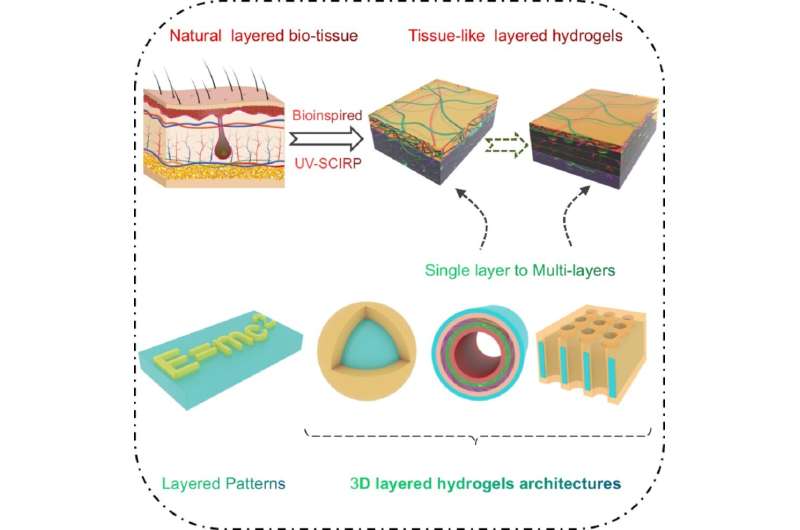New method to fabricate tissue-like wet and slippery hydrogels

Chinese researchers recently demonstrated an innovative chemical method for engineering diverse layered hydrogels with wet and slippery features at room temperature.
This method, known as "ultraviolet-triggered surface catalytically initiated radical polymerization (UV-SCIRP)," was proposed by Prof. Zhou Feng's group from the Lanzhou Institute of Chemical Physics (LICP) of the Chinese Academy of Sciences (CAS).
Numerous natural materials and biotissues-from nacres to muscle and arteries-possess microstructures with layered compositions and aligned architecture that are very beneficial because they have unique material properties and desirable multifunctionality.
For this reason, constructing layered structural hydrogels that are wet and slippery, anisotropic and hierarchical has attracted the interest of the biomedical, robotics and soft device fields due to their natural tissue-like properties.
Formation of natural, layered biotissue is a time-dominated living growing process by which the micro-network structure, geometry, thickness, composition and mechanical properties of each layer can be finely controlled.
"For current preparation techniques, they are typically physical manufacturing routes, like mechanically building a wall by continuously stacking bricks," said Dr. Ma Shuanhong, corresponding author of the study.
By adopting the redox mechanism, the researchers generated Fe2+ catalysts in situ on the surface of the hydrogel substrate, resulting in fast radical polymerization of monomer at the solid-liquid interface, along with the controllable growth of an interpenetrated single or multi-layered hydrogel network coating at room temperature.
According to the researchers, reiterative application of UV-SCIRP enables fabrication of multi-layered hydrogels with diverse components and layer features. The surface-catalyzed gelation enables the method to efficiently construct complex hydrogel patterns, non-flat arbitrary-shaped hydrogel objects and blood vessel-like intricate multi-layered hydrogel tubes.
The UV-SCIRP method appears suitable for effortlessly modifying the surface wettability and lubricating properties of hydrogels materials. It will have a transformative impact in the fields of polymer science and surface/interface science.
"It offers a completely new way to develop bio-inspired, layered hydrogel structures with wet and slippery features that are suitable for a wide range of applications including tissue-like models, soft robots and intelligent devices," said Prof. Zhou.
This study was published online in Matter.
More information: Shuanhong Ma, Continuously Growing Multi-layered Hydrogel Structures with Seamless Interlocked Interface, Matter (2021). DOI: 10.1016/j.matt.2021.11.018. www.cell.com/matter/fulltext/S2590-2385(21)00580-4
Journal information: Matter
Provided by Chinese Academy of Sciences





















